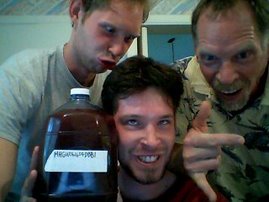

Hey guys,
Well its been too long since we've posted to the blog so I'd thought I would let you guys know where I'm at in my brewing. Right now, I've got a Guiness clone (Irish Stout) sitting in the primary fermenter. I'll be moving it to secondary tonight. This will be my fourth beer and its definitely getting more routine. I am getting tired of bottling though... I can't seem to get all the bottles off my counter at one time. And storing and cleaning the things takes up a lot of time. I've looked into kegging the whole batch to a
Cornelius Keg but the system ends up costing around $250-$300 once you buy the keg, the tap, the CO2 regulator, etc. But I have been seeing these little Heineken mini kegs at the store and I wondered if they could be reused to store homebrew. It turns out that the Heineken kegs can't be reused, but in searching I stumbled onto a system that uses similar mini kegs (5 liters). Basically it is composed of these 5L mini kegs (requires 4 minikegs for a 5 gallon batch of homebrew), a combination tap and CO2 regulator from the Tap-a-Draft system and an adaptor that goes between the keg and the tap/regulator. The Tap-a-draft system itself uses 6L plastic bottles to hold that beer that look like giant soda bottles. Personally, I think the minikeg option is better in terms of portability and long-term storage and the cost comes out to about the same. THe minikegs are around $7-$10 each and the tap/C02 regulator runs around $45. The neat thing about the tap/CO2 regulator is that it uses 2 CO2 cartridges (box of 12 is $7 and lasts about three homebrew batches). Since it uses 2 cartridges, you can substitute an N20 cartridge and have the necessary gas mixture for that characteristic Guiness Foam in your stouts. Anyway, I thought that this setup could really be used if we wanted to bring some seasonal ale up to the Mountain house or to Greensboro during the Holidays.
I've been brewing with a guy that Jenny works with, Patrick. He and his girlfriend are very much into brewing and this will be the second beer we've worked together on. This Guiness clone has been very different from the others. First off, its uses much darker roasted grains and a much thicker malt extract. In addition to the hops it also called for
Irish Moss which acts as a clarifier during fermentation.
The brew was so thick, in fact, that the hops and Irish Moss particulates did not settle to the bottom during the cooling process after the boiling. In both the porters and the Witbier, simply siphoning the cooled wort into the fermenter and taking care not to let the hose suck from the bottom of the pot was all that was needed to avoid adding the boiled hops into the mix. But this time around, pretty much all of the hops and irish moss made it into the primary vessel. I am hoping that the addition of the spring water will have diluted the mix enough that that stuff settles out and I won't have to strain the beer into the secondary vessel. I am also hoping that the particulates won't make the beer too bitter.
Guiness is a really bitter beer and definitely has a touch of sourness to it (actually the sourness comes from a special "Acid Malt" that is steeped along with the other roasted barleys and malts ), but I'm curious to see if it is too bitter. I really hope not.
Anyway, I will be moving it to secondary tonight (Monday 10/22) and bottling (yes, unfortunately, the mini keg system will have to wait) it probably Friday. So in about a week or so, I will have a taste report for you.



